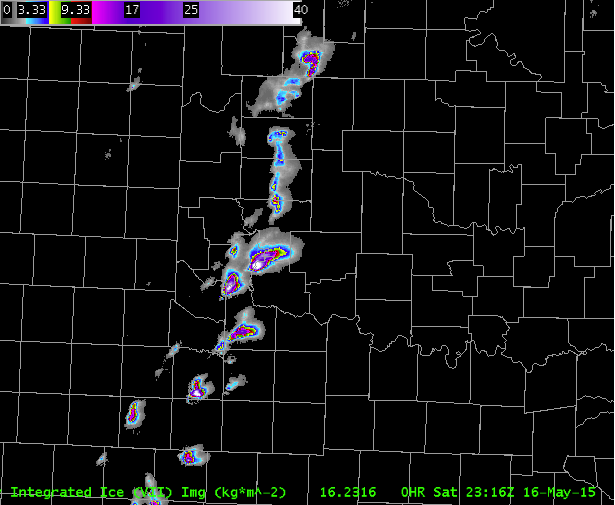Vertically Integrated Ice (VII) - Warning Decision Training Division (WDTD)
Navigation Links
Products Guide
Vertically Integrated Ice (VII)
Short Description
Radar-derived estimate of frozen water in a vertical column.
Subproducts
None
Primary Users
NWS: WFO, SPC
Input Sources
3D Reflectivity Cube
Vertical temperature profile from the current operational NCEP/EMC mesoscale model (i.e., the RAP as of 2014).
Resolution
Spatial Resolution: 0.01o Latitude (~1.11 km) x 0.01o Longitude (~1.01 km at 25oN and 0.73 km at 49oN)
Temporal Resolution: 2 minutes
Product Creation
In an empirical study, Carey and Rutledge (2000) found the contribution of ice mass within observed horizontal reflectivity and computed a reflectivity-ice mass (Z-M) relationship. This Z-M relationship was used by Mosier et al. (2011) to calculate VII using:

where ρi is the density of ice (917 kg m-3), No is the intercept parameter (4 x 106 m-4) of an exponential size distribution of precipitation-sized ice, Z is radar reflectivity, and H-10 and H-40 indicate the heights of the -10 and -40°C environmental levels in meters, respectively.
The vertical integration is constrained to the thermodynamic layer between -10 and -40°C, which is the graupel/ice growth layer within a thunderstorm.
Technical Details
Latest Update: MRMS Version 11.5
References
Carey, L.D., and S. A. Rutledge, 2000: The relationship between precipitation and lightning in tropical island convection: A C-band polarimetric study. Mon. Wea. Rev., 128, 2687-2710.
Greene, D.R., and R.A. Clark, 1972: Vertically integrated liquid water-A new analysis tool. Mon. Wea. Rev., 100, 548-552.
Mosier, R.M., C. Schumacher, R.E. Orville, and L.D. Carey, 2011: Radar nowcasting of cloud-to-ground lightning over Houston, Texas. Wea. Forecasting, 26, 199-212.




